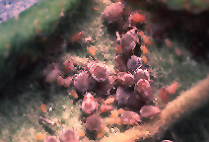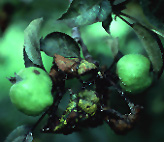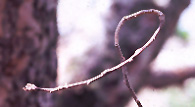 Rosy Apple Aphid, Dysaphis plantaginea
(Passerini)
Rosy Apple Aphid, Dysaphis plantaginea
(Passerini)
I. Introduction: The rosy apple aphid
(RAA)
has been a major pest of apple trees in North
America since the end of the 19th century. It is the most serious
of
the five aphid species
attacking apple, causing leaf, fruit and systemic root damage. In
severe outbreaks, up to fifty
percent of the fruit have been injured.
II. Hosts: The primary (overwintering) host of the RAA is
apple.
During early summer,
winged females move to the secondary (summer) host, narrowleaf
plantain. This plant is an introduced weed pest.
III. Description: The egg, which is deposited on the bark
of
spurs and shoots in the fall,
is oval and about 2/100 inch (0.4 mm) long. When first laid it is
a
bright yellow, but it gradually
changes to greenish-yellow and finally becomes a shiny jet black.
The
time required for these color
changes varies under normal outdoor conditions from about 9 days
to
more than 2 weeks.
The immature aphids that hatch from the eggs in spring are all
viviparous (giving live birth),
wingless females and when mature are called "stem mothers". The
body of
the immature aphid changes
color as it matures, from a dark green immediately after hatching
to a
more purplish or rosy tinge
when full grown (Plate 38). The immature aphids possess long
cornicles
at the base of the abdomen and also have long
antennae which extend almost half the length of the body. The
antennae
of young apple grain aphid stem
mothers reach only about to the end of the thorax. The winged
adults
are black and also possess long cornicles
and antennae.
The summer generations on plantain look distinctly different from
the
spring aphids on apple.
They are a pale yellowish color, and occur singly or in low
numbers,
rather than in dense colonies.
Plantain leaves are not curled by aphid feeding. Males are scarce
and
are only found in the fall. Oviparae,
also present only in the fall, have a prominent central tubercle
on the
front of the head, separating
this species from green aphids and apple grain aphid. There are
six
antennal segments, further separating
rosy apple aphid from apple grain aphid.
IV. Biology: The eggs usually hatch when buds are at the
silver
tip stage in spring. The eggs do
not hatch all at once but continue over a period of about 2 weeks.
Egg
hatch is complete by the half-inch
green stage. The young, as soon as they hatch, seek out the
opening
buds of apple, seeming to prefer the fruit buds.
They feed on the outside of the leaf bud and fruit bud clusters
until
the leaves begin to unfold. Then they work
their way down inside the clusters and begin sucking the sap from
the
stems and newly formed fruits. One nymph
feeding for 24 hours is sufficient to cause the leaf to be curled
when
it unfolds. The first stem mothers usually
reach maturity when apple trees are coming into pink. They settle
down
and content themselves with feeding and
producing young at a rapid rate. The production of young usually
begins
2 or 3 days after the last molt and
continues without interruption for over a month. A single female
produces an average of about 185 young. Normally,
the period of reproduction extends from about pink to June 20 or
later.
Usually the maximum period of
productive activity is around the last week of May and the first
week
of June. This is usually the period
when young fruits are beginning to set and to start active growth.
Populations are usually greatest in the
inner and upper parts of the canopy. There are approximately three
generations produced on apple with the
second generation occurring 2 to 3 weeks after petal fall and the
third
generation appearing by mid- to late
June. With each succeeding generation of aphids, a larger
percentage of
alate (winged forms) are produced. By
early to mid July all aphids have developed into alates and have
dispersed from apple to summer hosts. About
six generations occur on narrowleaf plantain (WSSA
photo) during the summer before winged females fly back to
apple in
the
fall. These females produce wingless oviparae, which mate with
returning winged males from the summer
hosts. The mated females deposit an average of 4-6 overwintering
eggs,
usually in late October and November.
V. Injury: RAA remove plant juices from the leaves, causing
severe curling (Plate 39) and abscission,
and twisting of growing shoots (Plate 40). They secrete large
quantities of honeydew which provides a substrate
for a black sooty fungus which can affect fruit finish. However,
the
most serious effect results from the
translocation of saliva from the leaves to the fruit. This causes
the
apples to remain small and deformed and
renders them unmarketable. Systemic effect of the toxic saliva
include
reduced growth of roots and other woody
tissue. Research at VPI&SU has shown that this can have an
important impact on young trees as they develop a
mature bearing structure.

 VI. Monitoring: Examine twigs in the dormant period for
overwintering eggs, to aid in selecting timing
of delayed dormant sprays. Research at the Penn State Fruit
Research
Laboratory in 1980 demonstrated that an
application of a contact insecticide at the green tip to half-inch
green stage provided optimum control of the RAA.
This application timing was selected initially because no method
exists
for distinguishing the overwintering eggs
of RAA from those of the other four species of aphid overwintering
on
apple as eggs, or for predicting aphid
populations based on egg numbers. If this application is not made
or
the orchardist wishes to assess the
effectiveness of this application, RAA can be sampled by selecting
five
to ten trees (preferably from the cultivars
`Rome Beauty', `Yorking', `Golden Delicious' or `Stayman') in an
orchard at the early pink to pink stage of apple
development. The sampling should be done early enough to allow the
application of an aphicide to the trees if the
threshold is exceeded. Make a 3-minute examination of each tree
and
count the number of fruit spurs showing curled
leaves with live aphids. Average the number of fruit spurs across
all
trees to calculate the number of spurs
showing evidence of rosy apple aphid infestation.
VI. Monitoring: Examine twigs in the dormant period for
overwintering eggs, to aid in selecting timing
of delayed dormant sprays. Research at the Penn State Fruit
Research
Laboratory in 1980 demonstrated that an
application of a contact insecticide at the green tip to half-inch
green stage provided optimum control of the RAA.
This application timing was selected initially because no method
exists
for distinguishing the overwintering eggs
of RAA from those of the other four species of aphid overwintering
on
apple as eggs, or for predicting aphid
populations based on egg numbers. If this application is not made
or
the orchardist wishes to assess the
effectiveness of this application, RAA can be sampled by selecting
five
to ten trees (preferably from the cultivars
`Rome Beauty', `Yorking', `Golden Delicious' or `Stayman') in an
orchard at the early pink to pink stage of apple
development. The sampling should be done early enough to allow the
application of an aphicide to the trees if the
threshold is exceeded. Make a 3-minute examination of each tree
and
count the number of fruit spurs showing curled
leaves with live aphids. Average the number of fruit spurs across
all
trees to calculate the number of spurs
showing evidence of rosy apple aphid infestation.
In 1981, researchers at the Penn State Fruit
Research Laboratory established a relationship between the
density of the RAA and fruit damage. They found that the number
of
infested fruit spurs per tree in a 3-minute
search at the early pink to pink stage of apple development was
directly related to the number of damaged apples
per tree at harvest. This relationship assumes that the aphids
attack
the blossom clusters at random and the
aphid-infested cluster yields one injured apple. From this
relationship, they proposed that if the grower
finds an average of one infested cluster per tree at the pink
stage
then a chemical treatment is needed.
If any live colonies of aphids are found at petal fall, an
additional
application of insecticide should be applied.
See Pennsylvania,
Utah,
and
California
factsheets.
This is taken primarily from a chapter by
D.G.
Pfeiffer, L.A. Hull, D.J. Biddinger, & J.C. Killian on apple
indirect pests, reprinted with permission from Mid-Atlantic
Orchard
Monitoring Guide, published by NRAES, 152 Riley-Robb Hall,
Ithaca,
New York 14853-5701.
Back to Virginia
Apple
Page
Back to Home Page for "Arthropod Management
in
Fruit Crops" course
Back to Virginia
Fruit
Page